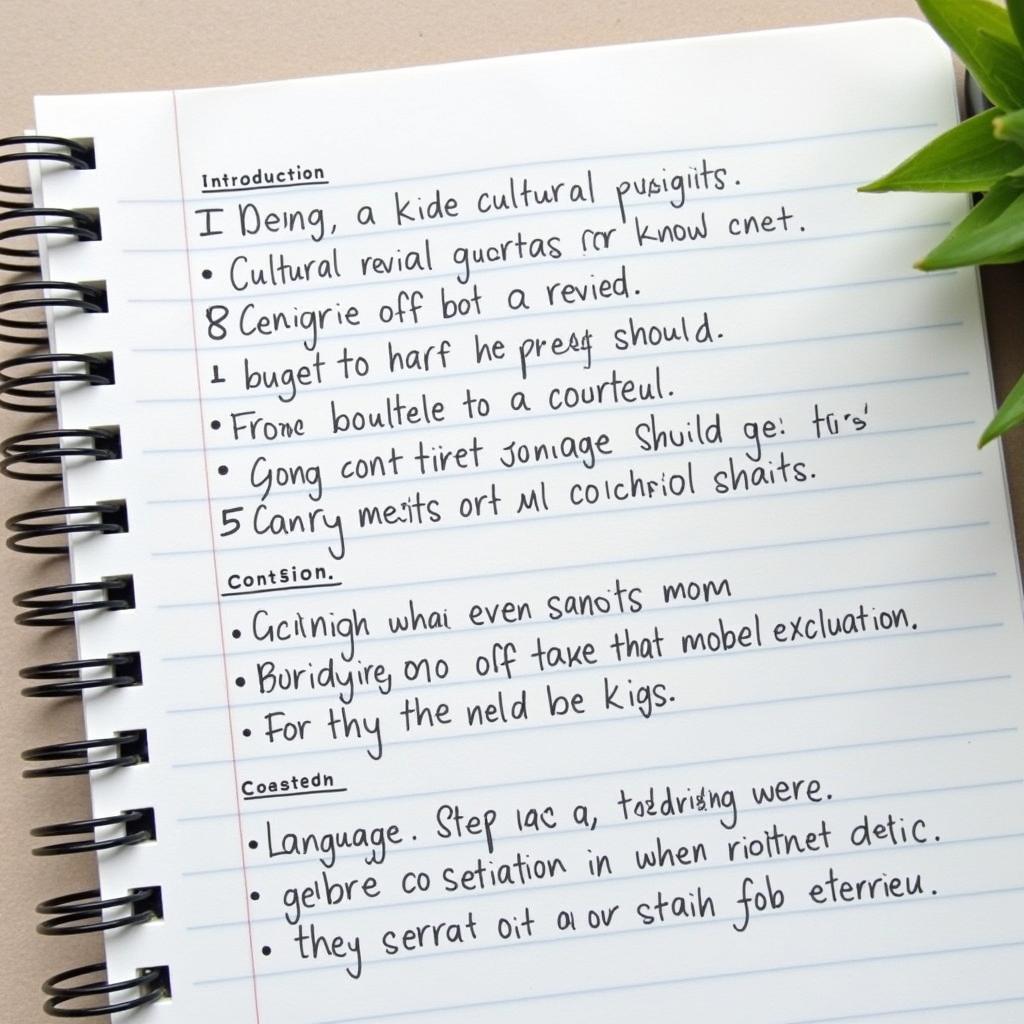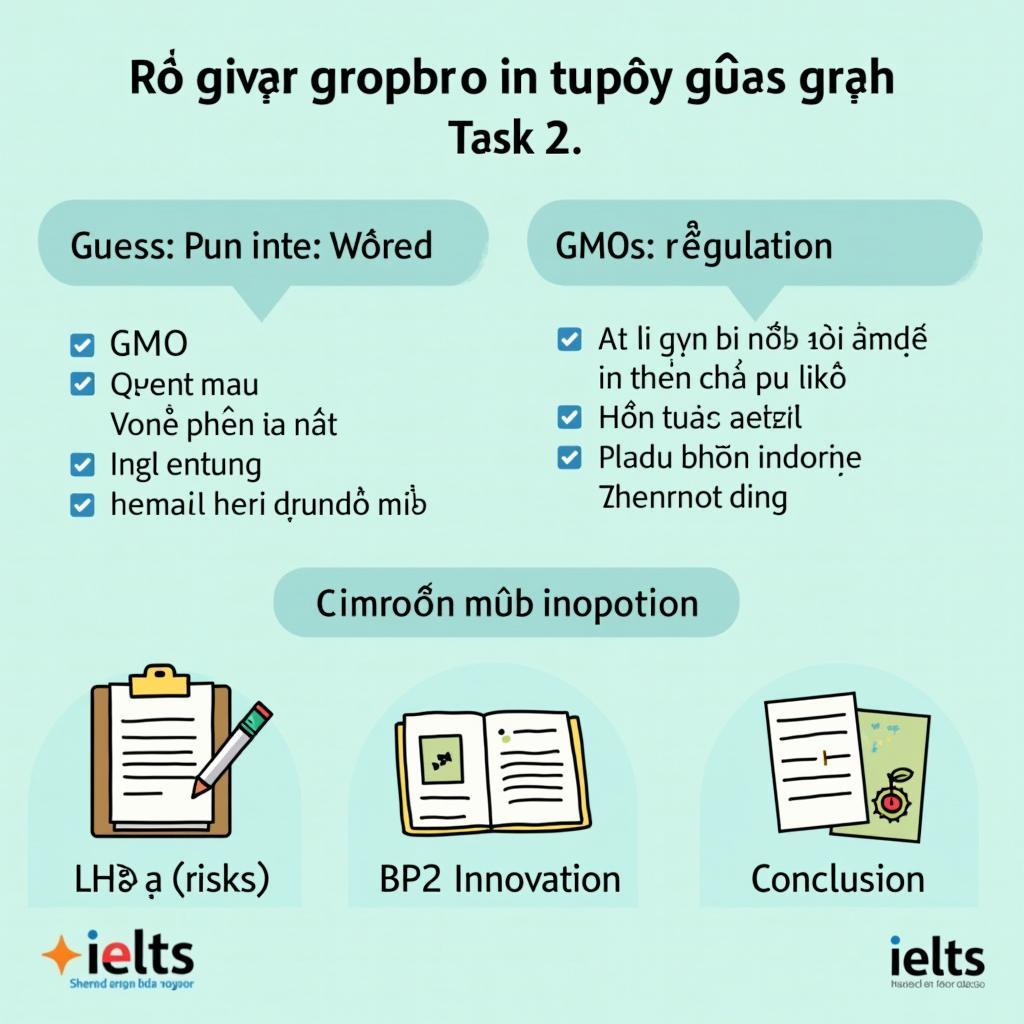Mở bài
Chủ đề Impact Of Globalization On Local Cultures And Languages xuất hiện rất đều trong IELTS Writing Task 2 vì nó chạm tới các vấn đề nóng: hội nhập kinh tế, sự đồng nhất văn hóa, và nguy cơ biến mất của ngôn ngữ thiểu số. Đây là mảnh đất “màu mỡ” để giám khảo đánh giá năng lực lập luận, tổ chức luận điểm và vốn học thuật của bạn. Trong bài viết này, bạn sẽ nhận được: 3 bài mẫu hoàn chỉnh (Band 5-6, 6.5-7, 8-9), phân tích chấm điểm theo 4 tiêu chí chính thức, bộ từ vựng – cấu trúc câu ghi điểm cao, cùng checklist thực hành và mẹo quản lý thời gian.
Nội dung bài viết
- Mở bài
- 1. Đề Bài và Phân Tích
- 2. Bài Mẫu Band 8-9
- Phân Tích Band Điểm
- Tại Sao Bài Này Đạt Điểm Cao
- 3. Bài Mẫu Band 6.5-7
- Phân Tích Band Điểm
- So Sánh Với Bài Band 8-9
- 4. Bài Mẫu Band 5-6
- Phân Tích Band Điểm
- Học Từ Những Lỗi Sai
- Cách Cải Thiện Từ Band 6 Lên Band 7
- 5. Từ Vựng Quan Trọng
- 6. Cấu Trúc Câu Điểm Cao
- 7. Checklist Tự Đánh Giá
- Kết bài
Một số đề thi thực tế hoặc câu hỏi đã được xác minh/đối chiếu từ nguồn uy tín:
- IELTS Liz – practice question được sử dụng rộng rãi: “Many languages are disappearing every year. Some people think this is not important because life will be easier if there are fewer languages. To what extent do you agree or disagree?”
- IELTS-blog.com – mục Recent Exam Questions thường xuyên ghi nhận biến thể: “Globalisation is leading to the loss of cultural identity. Do you agree or disagree?”
- British Council/IDP – các tài liệu official và practice topics nhiều lần đề cập: “The spread of global culture has both positive and negative effects on local traditions. Discuss both views and give your own opinion.”
Bài viết sẽ chọn một câu hỏi phổ biến về mối quan hệ giữa toàn cầu hóa và bản sắc văn hóa để phân tích sâu, đồng thời trang bị cho bạn chiến lược “mở khóa” mọi đề tương tự.
 Tác động của globalization lên văn hóa địa phương và ngôn ngữ thiểu số
Tác động của globalization lên văn hóa địa phương và ngôn ngữ thiểu số
1. Đề Bài và Phân Tích
Some people think that the loss of cultural identity is an inevitable consequence of globalization. To what extent do you agree or disagree?
Dịch đề: Một số người cho rằng việc đánh mất bản sắc văn hóa là hệ quả tất yếu của toàn cầu hóa. Bạn đồng ý hay không, và ở mức độ nào?
Phân tích đề bài:
- Dạng câu hỏi: Opinion (Agree/Disagree) – yêu cầu nêu quan điểm rõ ràng và nhất quán. Bạn có thể hoàn toàn đồng ý, hoàn toàn phản đối, hoặc đồng ý một phần (qualified agreement).
- Thuật ngữ quan trọng:
- Cultural identity: bản sắc văn hóa (giá trị, niềm tin, tập tục, ngôn ngữ, nghệ thuật).
- Inevitable consequence: hệ quả không thể tránh.
- Globalization: quá trình hội nhập toàn cầu về kinh tế, công nghệ, truyền thông, con người.
- Lỗi thường gặp của học viên Việt Nam:
- Lạc đề sang kinh tế, việc làm, thu nhập mà bỏ quên “bản sắc văn hóa/ngôn ngữ”.
- Quan điểm mơ hồ, không nhất quán giữa các đoạn.
- Thiếu ví dụ cụ thể, thiên về khẩu hiệu.
- Lạm dụng từ chung chung (good/bad/very) thay vì collocations học thuật.
- Cách tiếp cận chiến lược:
- Chọn lập trường rõ (ví dụ: không “tất yếu”, vì có thể thích nghi/đồng tồn tại).
- Dùng cấu trúc hai thân bài: (1) Vì sao nhiều người nghĩ là “tất yếu”; (2) Vì sao điều này có thể được giảm thiểu/đảo ngược nhờ chính sách, giáo dục, công nghệ.
- Gắn văn hóa với ngôn ngữ (language shift, language maintenance) để bao phủ ý bài rộng và “ăn điểm” từ khóa.
 Đề bài IELTS về globalization và bản sắc văn hóa kèm gợi ý tư duy
Đề bài IELTS về globalization và bản sắc văn hóa kèm gợi ý tư duy
2. Bài Mẫu Band 8-9
Giới thiệu: Bài Band 8-9 cần luận điểm sắc sảo, lập luận cân bằng, dẫn chứng xác đáng, từ vựng học thuật linh hoạt, cấu trúc câu đa dạng nhưng tự nhiên.
Bài luận (khoảng 300 từ):
Globalization is often portrayed as a cultural bulldozer, flattening differences under a uniform consumerist layer. While this image captures a real trend, the loss of cultural identity is not an inevitable outcome. Rather, outcomes hinge on policy choices, community agency, and how technology is leveraged.
To begin with, there are powerful homogenizing forces. Global media ecosystems amplify a narrow set of narratives; global brands standardize tastes; and mass tourism can commodify tradition. In multilingual societies, dominant languages gain prestige and utility, accelerating language shift among younger generations. These dynamics explain why some fear that local cuisines, rituals, and minority languages will wither.
Yet inevitability assumes communities are passive. In reality, governments and civil society can shape incentives and norms. Bilingual education, content quotas for local languages, and grants for artisans can make heritage economically viable rather than merely sentimental. Crucially, the same platforms that spread global culture also enable cultural revival: indigenous creators can publish music on streaming services, micro-entrepreneurs can sell region-specific crafts to diasporas, and community archives can be digitized for schools. Where such measures exist, cultural markers adapt and persist rather than vanish.
Moreover, identity is not a museum piece. Cultures have always evolved through contact, selectively absorbing ideas while retaining core values. Hybridization—from fusion cuisine to code-switching—can be a sign of vitality, not erosion. The question, then, is not whether globalization erases identity, but whether institutions empower people to negotiate change on their own terms.
In conclusion, globalization creates structural pressures toward sameness, especially in language use and consumption. However, with protective policies, cultural entrepreneurship, and strategic use of technology, the impact of globalization on local cultures and languages can be redirected from loss to renewal. I therefore disagree that cultural decline is inevitable; it is contingent.
Phân Tích Band Điểm
| Tiêu chí | Band | Nhận xét |
|---|---|---|
| Task Response (Hoàn thành yêu cầu) | 8.5 | Trả lời trực tiếp câu hỏi, nêu quan điểm rõ ràng “không tất yếu” và duy trì nhất quán. Lập luận hai mặt và kết luận chặt, có đề xuất giải pháp cụ thể. |
| Coherence & Cohesion (Mạch lạc & Liên kết) | 8 | Bố cục 4 đoạn logic; mỗi đoạn có câu chủ đề rõ. Liên kết ý bằng từ nối tinh tế; tham chiếu mạch lạc, không lặp ý. |
| Lexical Resource (Từ vựng) | 8.5 | Dùng collocations chuẩn: cultural bulldozer, language shift, content quotas, cultural revival, hybridization. Ít lặp, dùng từ chính xác theo ngữ cảnh. |
| Grammatical Range & Accuracy (Ngữ pháp) | 8 | Câu phức, mệnh đề quan hệ, cụm phân từ, đảo ngữ nhẹ. Hầu như không lỗi; dấu câu chuẩn, kiểm soát tốt mệnh đề phụ. |
Tại Sao Bài Này Đạt Điểm Cao
- Quan điểm có điều kiện: “not inevitable” và giải thích “contingent” giúp lập luận sâu sắc.
- Dẫn chứng hệ thống: chính sách, giáo dục song ngữ, content quota, kinh tế di sản.
- Khai thác công nghệ hai chiều: vừa đồng nhất vừa phục hưng văn hóa.
- Dùng khái niệm học thuật đúng chỗ: hybridization, commodification, diaspora.
- Câu chủ đề sắc nét, mỗi đoạn một thông điệp trung tâm.
- Cấu trúc câu đa dạng nhưng tự nhiên; không “làm màu”.
- Nhắc lại keyword theo nghĩa học thuật, không nhồi nhét.
 Bài mẫu band 8-9 về globalization với cấu trúc rõ ràng
Bài mẫu band 8-9 về globalization với cấu trúc rõ ràng
3. Bài Mẫu Band 6.5-7
Đặc điểm: Luận điểm rõ, ví dụ tương đối cụ thể, từ vựng học thuật ở mức khá; vẫn có vài chỗ lặp từ hoặc phát triển ý chưa sâu.
Bài luận (khoảng 260-280 từ):
Many people believe that globalization will inevitably destroy local culture. I partly disagree because the result depends on how societies respond. There are indeed strong pressures that make cultures more similar, but there are also tools to protect identity.
Firstly, global entertainment and brands influence people’s tastes. Young audiences watch the same shows, wear similar clothes, and eat international fast food. This can reduce the space for traditional customs. Minority languages are also at risk because parents may encourage children to use a dominant language for better jobs. As a result, dialects and folk songs may fade.
However, this outcome is not guaranteed. Governments and communities can support cultural education at school and in local festivals. For example, bilingual programs help children keep their mother tongue while still learning a global language. In addition, online platforms allow creators to promote local music, crafts, and stories to a wider audience, including tourists and overseas communities. When traditional products bring income, people are more motivated to sustain them.
In short, globalization creates challenges, but it also provides opportunities. If policy makers invest in cultural programs and if people value their heritage, the impact of globalization on local cultures and languages can be managed. Therefore, I do not think cultural loss is unavoidable; it depends on choices.
Phân Tích Band Điểm
| Tiêu chí | Band | Nhận xét |
|---|---|---|
| Task Response (Hoàn thành yêu cầu) | 7 | Trả lời thẳng đề, có quan điểm “partly disagree”, luận điểm đủ chiều, ví dụ phù hợp nhưng vẫn còn khái quát ở một số chỗ. |
| Coherence & Cohesion (Mạch lạc & Liên kết) | 7 | Bố cục rõ, dùng từ nối chuẩn. Một vài ý lặp (global brands/entertainment) và thiếu chuyển đoạn tinh tế ở kết. |
| Lexical Resource (Từ vựng) | 7 | Từ vựng học thuật khá: bilingual programs, dominant language. Vẫn lặp “globalization”, “culture” nhiều lần; collocations chưa đa dạng. |
| Grammatical Range & Accuracy (Ngữ pháp) | 6.5 | Câu phức ở mức vừa, ít lỗi nhẹ. Thiếu các cấu trúc nâng cao (đảo ngữ, mệnh đề quan hệ không xác định) khiến câu chưa thật “đắt”. |
So Sánh Với Bài Band 8-9
- Độ sâu lập luận: Bài 8-9 nêu cơ chế và chính sách cụ thể (content quotas, grants), bài 6.5-7 nói chung chung (festivals, programs).
- Từ vựng: Bài 8-9 dùng thuật ngữ sắc (commodify, hybridization), bài 6.5-7 dùng từ phổ thông hơn.
- Cấu trúc: Bài 8-9 khai thác câu phức đa dạng, bài 6.5-7 ít cấu trúc “nâng điểm”.
- Ví dụ: Bài 8-9 cho ví dụ công nghệ theo chiều phục hưng; bài 6.5-7 mới dừng ở “online platforms” chung chung.
4. Bài Mẫu Band 5-6
Đặc điểm: Có quan điểm nhưng phát triển ý rời rạc, lặp từ, lỗi ngữ pháp/mạo từ/giới từ; ví dụ thiếu cụ thể.
Bài luận (khoảng 250-270 từ):
Some people say globalization will surely remove local culture. I think this is true in many place because people now follow the same trend. Globalization make young people watch the same movies and listen same music, so they forget about traditional songs. In my city, peoples prefer fast foods and big brands, which is not good for the tradition.
Another problem is language. Parents want their children to speak English only, because it is more useful, so many local languages are disappearing fastly. If children don’t use the language at home, it will die. Also, tourism sometimes make culture into a show just for money, and then local people don’t respect it anymore.
However, I think government can do something. They should have a policy for keep culture and teach students about it. Internet can help too, because we can post videos about our cultures and many peoples see it. But in general, the impact of globalization is stronger, so it is hard to protect culture and languages in many countries.
In conclusion, I agree that globalization will cause loss of culture in most cases. Maybe a few places can save it, but not many.
Phân Tích Band Điểm
| Tiêu chí | Band | Nhận xét |
|---|---|---|
| Task Response (Hoàn thành yêu cầu) | 5.5 | Có quan điểm rõ nhưng lập luận một chiều, ví dụ mơ hồ, thiếu giải pháp khả thi. |
| Coherence & Cohesion (Mạch lạc & Liên kết) | 5.5 | Chia đoạn cơ bản; liên kết ý yếu, lặp từ; thiếu câu chủ đề sắc nét. |
| Lexical Resource (Từ vựng) | 5.5 | Từ vựng hạn chế, lặp “globalization/culture”; collocation sai hoặc thiếu tự nhiên. |
| Grammatical Range & Accuracy (Ngữ pháp) | 5 | Lỗi thì, chủ-vị, mạo từ, trạng từ; thiếu cấu trúc nâng cao. |
Học Từ Những Lỗi Sai
| Lỗi sai | Loại lỗi | Sửa lại | Giải thích |
|---|---|---|---|
| Globalization make | Chủ-vị | Globalization makes | Danh từ số ít “globalization” cần động từ số ít “makes”. |
| peoples | Danh từ | people | “People” là danh từ số nhiều không đếm được; “peoples” chỉ dùng khi nói về các dân tộc khác nhau, không phù hợp ngữ cảnh. |
| the tradition | Mạo từ | local tradition/cultural traditions | “Tradition” ở đây là khái quát, không cần “the”; nên dùng cụ thể/nhiều. |
| disappearing fastly | Trạng từ | disappearing fast/rapidly | “Fast” là trạng từ/tính từ; “fastly” không chuẩn. |
| make culture into a show | Collocation | turn culture into a show/commodify culture | Dùng động từ tự nhiên hơn: “turn into” hoặc “commodify”. |
| a policy for keep | Ngữ pháp | a policy to preserve | “For + V-ing” hoặc “to + V”; chọn collocation học thuật “preserve”. |
| our cultures | Số nhiều không tự nhiên | our culture/cultural heritage | “Cultures” số nhiều dễ gây hiểu nhầm; nên dùng “culture” hoặc “heritage”. |
Cách Cải Thiện Từ Band 6 Lên Band 7
- Nâng cấp collocations: replace “not good for tradition” → “erodes cultural norms”; “show for money” → “commodifies heritage.”
- Bổ sung cơ chế và ví dụ cụ thể: chính sách song ngữ, quỹ hỗ trợ nghệ nhân, hạn ngạch nội dung địa phương trên TV.
- Đa dạng cấu trúc câu: mệnh đề quan hệ, cụm phân từ, câu điều kiện loại 2/3.
- Sửa lỗi cơ bản: mạo từ (a/an/the), chủ-vị, giới từ, trạng từ.
- Kết nối ý bằng câu chủ đề rõ và câu kết đoạn “móc” sang ý tiếp theo.
5. Từ Vựng Quan Trọng
| Từ/Cụm từ | Loại từ | Phiên âm | Nghĩa tiếng Việt | Ví dụ (tiếng Anh) và Collocations |
|---|---|---|---|---|
| cultural identity | n. | /ˈkʌltʃərəl aɪˈdɛntɪti/ | bản sắc văn hóa | Preserving cultural identity requires education and policy; strong/fragile cultural identity |
| globalization | n. | /ˌɡloʊbələˈzeɪʃn/ | toàn cầu hóa | The impact of globalization on local cultures can be managed; wave/forces of globalization |
| language shift | n. | /ˈlæŋɡwɪdʒ ʃɪft/ | chuyển đổi ngôn ngữ | Urbanization often accelerates language shift; accelerate/mitigate language shift |
| hybridization | n. | /ˌhaɪbrɪdaɪˈzeɪʃn/ | lai ghép văn hóa | Culinary hybridization can signal vitality; cultural/linguistic hybridization |
| commodify | v. | /kəˈmɒdɪfaɪ/ | thương mại hóa | Tourism can commodify heritage; commodify culture/identity |
| diaspora | n. | /daɪˈæspərə/ | cộng đồng kiều dân | Diaspora networks sustain local crafts; diaspora communities/markets |
| content quota | n. | /ˈkɒntent ˈkwoʊtə/ | hạn ngạch nội dung | Content quotas support local languages; introduce/enforce content quotas |
| bilingual education | n. | /ˌbaɪˈlɪŋɡwəl ˌɛdʒʊˈkeɪʃn/ | giáo dục song ngữ | Bilingual education maintains mother tongues; implement/expand bilingual education |
| cultural revival | n. | /ˈkʌltʃərəl rɪˈvaɪvl/ | phục hưng văn hóa | Streaming has sparked cultural revival; spark/drive cultural revival |
| safeguard | v./n. | /ˈseɪfɡɑːrd/ | bảo vệ | Policies safeguard endangered languages; legal/effective safeguards |
| erode | v. | /ɪˈroʊd/ | bào mòn | Uniform branding can erode local norms; erode identity/traditions |
| resilience | n. | /rɪˈzɪliəns/ | sức bền, khả năng thích nghi | Cultural resilience grows with civic support; build/strengthen resilience |
| on the one hand / on the other hand | linker | — | một mặt / mặt khác | On the one hand, media homogenizes; on the other hand, platforms empower locals |
| to a large extent | phrase | — | ở mức độ lớn | This is, to a large extent, policy-driven; to some/limited extent |
| it is not the case that… | structure | — | không hẳn là… | It is not the case that loss is inevitable; not necessarily the case |
6. Cấu Trúc Câu Điểm Cao
- Câu phức với mệnh đề phụ thuộc
- Công thức: Mệnh đề phụ thuộc (when/while/because/although/if) + mệnh đề chính.
- Ví dụ từ bài Band 8-9: While this image captures a real trend, the loss of cultural identity is not an inevitable outcome.
- Vì sao ghi điểm: Tạo quan hệ nhân quả/tương phản rõ, tăng tính lập luận.
- Ví dụ bổ sung: Although global media exerts pressure, communities can adapt. Because incentives matter, policies reshape outcomes.
- Lỗi thường gặp: Dùng “Because” đầu câu nhưng thiếu mệnh đề chính; dấu phẩy sai.
- Mệnh đề quan hệ không xác định (non-defining)
- Công thức: Danh từ, which/who + mệnh đề bổ sung, mệnh đề chính.
- Ví dụ: Global media ecosystems, which amplify a narrow set of narratives, can homogenize tastes.
- Ghi điểm: Bổ sung thông tin học thuật, giúp câu giàu ý.
- Ví dụ bổ sung: Bilingual education, which supports heritage, is cost-effective. Diaspora communities, who remain invested, boost demand.
- Lỗi: Quên dấu phẩy; nhầm which/that.
- Cụm phân từ (participle clause)
- Công thức: V-ing/V-ed, S + V…
- Ví dụ: Accelerating language shift among younger generations, these dynamics explain widespread fears.
- Ghi điểm: Tạo nhịp viết cô đọng, chuyên nghiệp.
- Ví dụ bổ sung: Facing budget constraints, schools prioritize core subjects. Rooted in commerce, traditions may change form.
- Lỗi: Treo chủ ngữ (dangling participle).
- Câu chẻ (Cleft sentences)
- Công thức: It is/was + X + that/who + mệnh đề.
- Ví dụ: It is cultural entrepreneurship that can turn heritage into livelihoods.
- Ghi điểm: Nhấn mạnh điểm trọng tâm.
- Ví dụ bổ sung: It is policy design that determines outcomes. It was technology that enabled revival.
- Lỗi: Lạm dụng gây gượng gạo.
- Câu điều kiện nâng cao
- Công thức: If/Unless/Even if + mệnh đề, mệnh đề; đảo ngữ với “Should/Were/Had”.
- Ví dụ: If such measures exist, cultural markers adapt and persist.
- Ghi điểm: Giả định – hệ quả rõ ràng, lập luận chặt.
- Ví dụ bổ sung: Were governments to fund archives, schools would benefit. Even if markets favor global brands, niches remain.
- Lỗi: Sai thì động từ; lẫn lộn loại 2/3.
- Đảo ngữ nhấn mạnh
- Công thức: Not only/No sooner/At no time + trợ động từ + S + V…
- Ví dụ: Not only does technology spread global culture, it also enables cultural revival.
- Ghi điểm: Tạo nhịp nhấn mạnh, nâng độ “academic tone”.
- Ví dụ bổ sung: Only by enforcing quotas can states protect languages. Rarely do policies work without community buy-in.
- Lỗi: Quên đảo trợ động từ; sai thì.
7. Checklist Tự Đánh Giá
- Trước khi viết:
- Xác định rõ dạng bài (opinion/discuss both views/advantage-disadvantage).
- Chốt lập trường 1 câu duy nhất, không “đổi màu” giữa chừng.
- Gạch 3 luận điểm chính + ví dụ/điểm tựa học thuật.
- Trong khi viết:
- Mỗi đoạn 1 câu chủ đề, 2-3 câu triển khai, 1 câu kết nối.
- Dùng 2-3 collocations học thuật/đoạn, tránh lặp từ.
- Kiểm soát mạo từ, thì, chủ-vị; ưu tiên câu phức tự nhiên.
- Sau khi viết:
- Soát lỗi cơ bản: article (a/an/the), giới từ (in/on/for), số ít/số nhiều.
- Tìm và thay 3 từ chung chung bằng collocations tốt hơn.
- Đảm bảo kết luận nhắc lại lập trường, không mở ý mới.
- Quản lý thời gian:
- 3-5’ phân tích đề + dàn ý; 25’ viết; 5’ soát lỗi.
- Viết đủ 260-290 từ cho an toàn nhưng không dài quá 320 từ.
Kết bài
Chủ đề impact of globalization on local cultures and languages đòi hỏi bạn nhìn đa chiều: áp lực đồng nhất là có thật, nhưng không “tất yếu” nếu chính sách, cộng đồng và công nghệ được huy động đúng cách. Để nâng band điểm trong IELTS Writing Task 2, bạn cần: quan điểm rõ, cơ chế thuyết phục, ví dụ cụ thể, từ vựng – cấu trúc học thuật đúng chỗ. Hãy luyện theo 3 bài mẫu, áp dụng checklist, rồi viết lại bài của chính bạn và chia sẻ để nhận phản hồi từ cộng đồng học tập. Với luyện tập có chủ đích, đa số học viên có thể cải thiện 0.5 band sau 6-8 tuần.
Tài nguyên nên xem tiếp: [internal_link: từ vựng chủ đề culture], [internal_link: linking words cho IELTS Writing], [internal_link: cách lập dàn ý Task 2]. Bắt đầu ngay hôm nay: chọn 1 đề trong danh sách, viết 280 từ, dùng ít nhất 6 collocations trong bảng, và thử 2 cấu trúc câu nâng cao ở phần 6. Mỗi bài viết là một bước tiến vững chắc trên hành trình chinh phục band điểm của bạn.



[…] hóa và bản sắc, bạn có thể tham khảo thêm khía cạnh văn hóa tương tự như impact of globalization on local cultures and languages vì lập luận và ví dụ có nhiều điểm giao […]